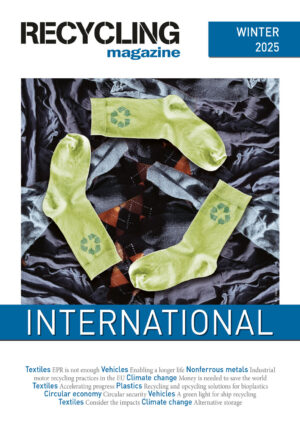News archive
-
In 2024, exports of recyclable raw materials, which include recyclable waste and scrap as well as other secondary raw materials (by-products), from the EU to non-EU countries amounted to 35.7 million tonnes, an 8.2% decrease compared with the previous year. 2023 was a record year for exports of recyclable raw materials, as volumes reached 38.9 million tonnes, the highest in 2 decades.
-
A new report released by Zero Waste Europe argues for bolder system-wide measures to address the EU’s material consumption. As the bloc prepares its much-anticipated Circular Economy Act, the report states that current policy measures are insufficient to reduce the absolute levels of resource use, a blindspot that threatens the EU’s strategic autonomy.
-
Furuya Metal and Asahi Kasei have, in collaboration with Nobian Industrial Chemicals and Mastermelt, embarked on a demonstration trial regarding the recycling of metals used for chlor-alkali electrolysis cells and the electrodes within those cells. Through this initiative, Furuya Metal will strive to build an ecosystem in the chlor-alkali industry using rare metal recycling.#
-
Martin Engineering has introduced a heavy-duty air cannon mounting system. The Martin X-Stand is an organization system that safely keeps air cannons away from super-heated or potentially hazardous areas while offering easy service access. The result is clearer walkways, improved safety, and greater maintenance efficiency for a lower cost of operation.
-
Plastics Recyclers Europe has established a new Dissolution Taskforce to reflect the technological advancements in the industry, following the collaboration with DROP-IN — Dissolution Recycling of Plastics Initiative.
-
The European Commission’s first Working Plan for implementing the Ecodesign for Sustainable Products Regulation (ESPR) has been published. It confirms the list of priority products this policy will tackle first to improve their sustainability – with almost all products on the EU market due to be covered eventually. The list includes textile apparel, furniture, mattresses, tyres, iron and steel, and aluminium.
-
The Association of Plastic Recyclers (APR) and RecyClass have published the second progress report of their collaboration, which aims to accelerate the global harmonisation of plastic recyclability.
-
Polyhydroxyalkanoates (PHA) are biocompatible and biodegradable plastics in soil and marine environments synthesised by a wide variety of microorganisms, which share very similar characteristics with plastics of petrochemical origin.
-
Creating a circular automotive sector requires more than just commitments; it demands a robust regulatory framework that promotes fair, transparent practices and ensures the uptake of recycled materials.
-
Recycling of plastics plays a major role in the achievement of the European Union (EU) Green Deal objective, and Member States have to cope with increasingly stricter regulatory framework. In order to promote the use of recycled materials and sustainability of plastic bottle production, pursuant to the legislation, PET bottles must currently contain at least 25% recycled plastic and at least 30% of recycled material must be incorporated in all plastic beverage bottles by 2030.
-
The Plastics Recycling Show Europe shattered records in Amsterdam with over 500 exhibitors, more than 75 expert speakers, and an all-time high of 13,325 attendees over the two days.
-
The environmental network’s study “Designing EPR to Foster the EU’s Competitiveness and Strategic Autonomy” analyses 30 years of EPR implementation and proposes a comprehensive framework to transform EPR systems into catalysts …










